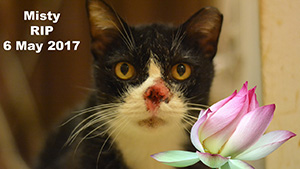
| Home | Gold-D Cat | Gold-D Dog | Gold-D Supplements | Gold-D Bodycare | AHA Homecare |
| Gold-D Countries | Resources | About | Contact |
Palliative care |
|
In our rescue work, we have undertaken palliative care for cats who have reached the end stage of their illness or sustained life limiting injuries. While this article is written based on our experience with cats, the issues are also relevant for other animals and even humans.It is also relevant to a pet who is dying and rescurers doing palliative care. Offering palliative care means that we accept that their medical condition is irreversible, and death is inevitable. The focus is on comfort care, pain management and emotional support. We want every cat to depart from a safe, loving and comfortable environment and for them to know that they are loved to the end. Working with vetsAlthough the cat is dying, the process may last several months. The vet can advise if treatment is feasible, advise on pain management and medications as well as when to terminate treatment. It is very helpful to work with a vet who shares the same vision and values. Managing advisePalliative care and death can be a taboo subject that not many people have thought in depth. In addition, cats who have lost a lot of weight or those with nose cancer can be visually disturbing to many people. A common response is to suggest euthanasia. If pain management is in place, the cat is happy and has quality of life, there is no reason to do so. The cat’s care giver is the best person to make that decision. At times, it is essential to simply ignore unsolicited demands and suggestions. Giving permission & Saying good byeFrom our experience, it helps to assure the dying cat that it can let go whenever its ready. We tell that we love them and will miss them. We also assure them that we will be alright after they depart. This way, they do not have to worry about us, making conditions conducive for them to let go. Euthanasia becomes a last resort when the cat experiences extreme pain, lost control of its bodily functions or immobile. If this is necessary, we will explain our decision to the cat and assure that it can leave anytime and not be worried about us. Managing emotionsWe believe it is important to be emotionally involved with the dying cat so that it feels loved. We talk to them, hug them and connect with them. Doing so can be emotionally demanding as we see the cat deteriorating or when the cat departs. As such, it is also important to accept that no amount of tears or sorrow will reverse the illness or their death. We focus on our affection for them and be happy that they are finally free from their ailing body. We thank them for this opportunity to care for them in the last chapter of their lives. Love and supportWhile feeing sad is a natural response to grief, it is necessary to seek counselling if the care giver becomes depressed. Having a loving family and supportive friends who understand and accept the importance of palliative care is very important. They offer support and an opportunity to discuss difficult issues. Final wordsTo offer palliative care, it is necessary to accept death as inevitable and to focus on the physical and emotional needs of the cat as it approaches death. It is about them and not us. Palliative care is a privilege to be with a cat in the last chapter of its life. This article is written in loving memory of all the cats whom we had the privilege to care for before they depart. |
  Ken Ken shutting down. final stage of FIV  Franics with nose cancer  Rahula was FIV and Felv+. He was abandoned when his owners discovered his condition. Expected to live for 3 weeks, he stayed with us for 8 mths before he departed.  Gold-D on iv drip. He passed way from kidney failure.  Uncle Sam Sam shutting down. He was an FIV+ cat with hearing loss, kidney issues and a stroke. Uncle Sam Sam shutting down. He was an FIV+ cat with hearing loss, kidney issues and a stroke.  Tahiti was a little kitten who had brain infection / injury. He passed away shortly after rescue. But he left with a name and left with love. |
You are on the Gold-D Global website.
|
| Join us on | Youtube | Tik Tok |